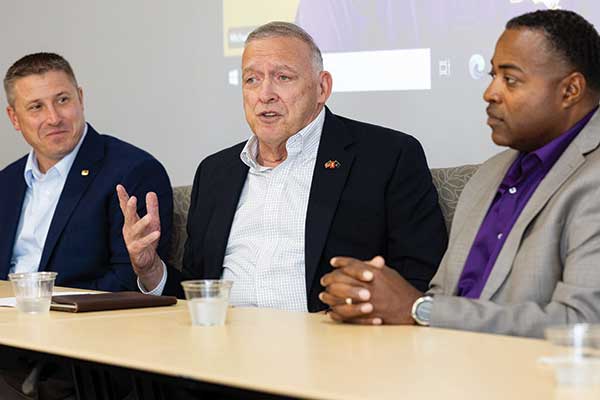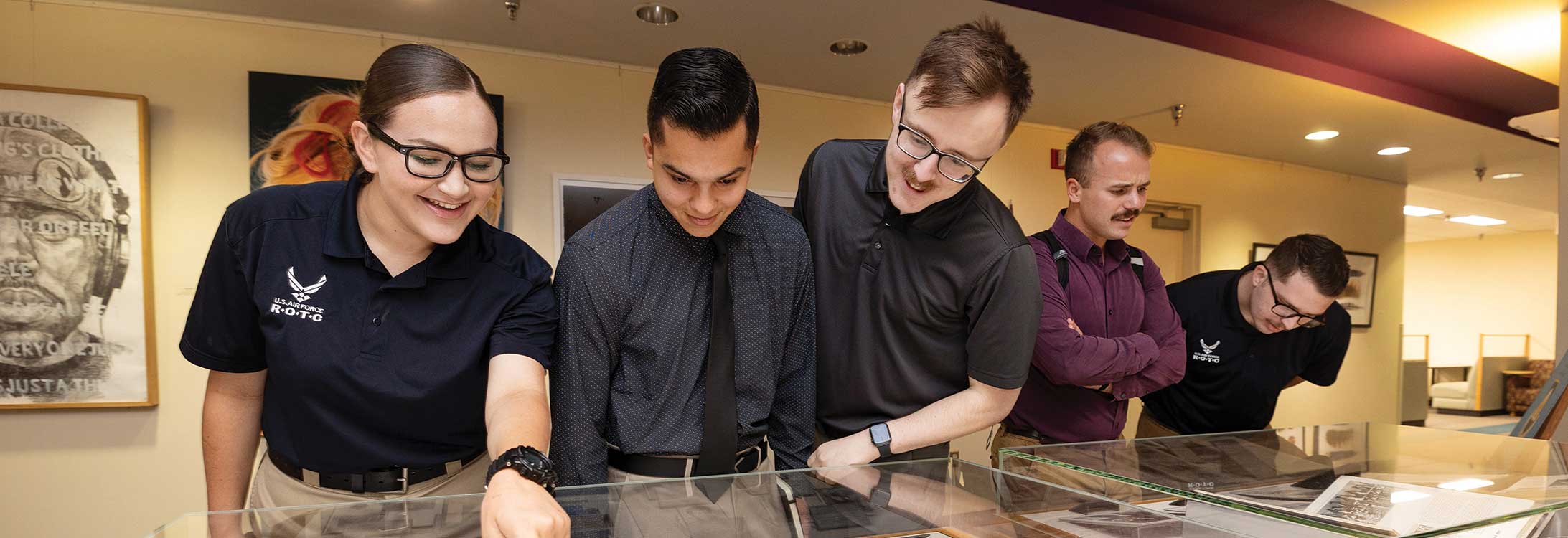Events highlight Air Force ROTC’s decades of impact and alumni
ECU this fall celebrated 75 years of its Air Force ROTC unit.

Retired Gen. Gary North, center, talks while flanked by Lt. Col. William Dye, left, and retired Col. Derrick Floyd during a panel discussion celebrating 75 years of ECU’s Air Force ROTC unit.
Stemming from a 1947 application initiated by then college President John Messick, Air Force ROTC Detachment 600 opened in 1948. Lt. Col. William Dye is the unit’s current commander.
The detachment has racked up accolades and achieved notable milestones since its inception, including in 2017 when it received the Right of Line award as the best medium-sized detachment in the United States. It is the second-largest detachment in the state of North Carolina.
A 75th anniversary ball was held at the Greenville Convention Center on Sept. 22. A Main Campus library exhibition, 75 Years of Detachment 600: East Carolina’s Air Force ROTC, was on display at Joyner Library during the fall semester. The detachment also is working with university advancement for an ongoing crowdfunding campaign.
“Our detachment, at 75 years, is only one year younger than our United States Air Force as a separate service,” said retired Gen. Gary North ’76, before a Sept. 22 panel discussion at the library exhibition. “You see graduates around the world, and when two or more are gathered, it’s ‘Go Pirates’ and about Pirate Nation, whether it’s during peace time or they’re civilians who graduated from the university and hold jobs in the industry, in government or in the uniform of our country. … The pride that Pirate Nation brings is just phenomenal.”
In 1969, the U.S. Air Force chose ECU as one of five detachments to accept women. Martha Van Hoy was the first woman to join East Carolina’s program, and in 1974, Mary Kathleen Langan was the detachment’s first female commissioned line officer.
Langan’s breakthrough came two years after William T. Mitchell was ECU’s first Black cadet to be commissioned, earning second lieutenant status in the U.S. Air Force.
“When I hear about those moments, I feel an overwhelming sense of pride,” cadet Coriel Grannis-Ezell said. “When I am commissioned, I will be a fourth-generation female officer. It goes all the way back to my great-grandmother with officers in the Air Force. That alone fuels my pride even more and is a big reason why I’m here.”
Famed SR-71 pilot Brian Shul has died
Shot down in Vietnam, Brian Shul ’70 recovered from severe burns not only to fly again but to fly the world’s fastest, highest-soaring aircraft. Shul died May 20 after delivering a speech in Reno, Nevada. He was 75.
Shul was a history major at ECU, then joined the Air Force after graduation. In 1973, his aircraft was shot down near the Cambodian border. Shul was unable to eject, and the explosive impact severely burned him, but he managed to survive in the jungle while evading enemy patrols until a rescue mission arrived.

Shul returned to flying just two days after being released from the hospital. He went on to pilot the SR-71 Blackbird, one of the most iconic aircraft in history. He retired in 1990, switching his focus to writing and photography. He was also a regular public speaker, recounting humorous, self-effacing stories about his adventures in the Air Force.
Aviation buffs know Shul as part of probably the world’s most famous groundspeed check, which took place 13 miles above Southern California. Here’s how he would tell it:
“I heard a Cessna ask for a readout of its groundspeed. ‘90 knots,’ Center replied. Moments later, a Twin Beech required the same. ‘120 knots,’ Center answered. … (A)lmost instantly an F-18 transmitted, ‘Ah, Center, Dusty 52 requests groundspeed readout.’ There was a slight pause, then the response, ‘620 knots on the ground, Dusty.’”
Shul and his crew mate couldn’t resist asking, too. “‘Center, Aspen 20, you got a groundspeed readout for us?’ There was a longer than normal pause. ‘Aspen, I show 1,942 knots’” — or 2,234 mph.
“No further inquiries were heard on that frequency,” Shul would say. ECU recognized him with an Outstanding Alumni Award in 2015.
